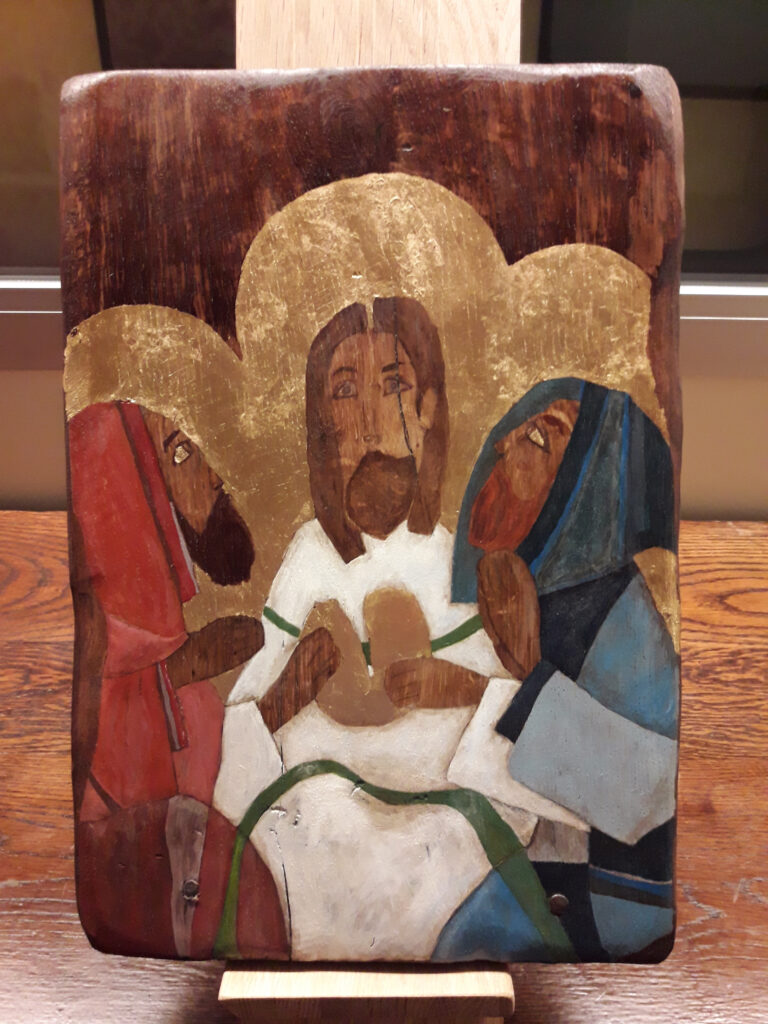
The paint tubes lay scattered across the table — crimson, ultramarine, aureolin. I squeezed dollops onto the palette, taking a deep breath to center myself. Canvas stretched before me, empty and expectant. Slowly, prayerfully, I began translating the image in my mind into shapes and hues. The afternoon melted into a flow of brushstrokes. When I finally stepped back, Christmas joy gazed back at me: the newborn Savior cradled in Mary’s arms.
Since childhood, making art has connected me to God. The creative process becomes an act of prayer, uniting matter and spirit. Shades of ink, clay, or cloth come alive with the divine presence.
RELATED: Picture This: Using Art As a Path to the Holy Spirit
For me, painting has been a particularly meaningful artistic medium. As a teenager, I would spend hours mixing oil paints to capture a glowing sunset or delicate flower. In the focused motions of the brush across canvas, I felt close to the creator of such beauty. The tactile experience made God’s presence tangible. Later, iconography became another impactful art form. The prayerful ritual of preparing the board, applying gesso, and painting the holy images immersed me in the saints’ witness. When the last highlight was in place, the icon reflecting back God’s light felt like an answered prayer.
The Catholic imagination recognizes art’s power to capture holy mysteries. Great masterpieces like Michelangelo’s Pietà and Andrei Rublev’s icon of the Trinity allow us to encounter Christ through the senses. I first became aware of this as a child gazing up at the Baroque sculpture and ornate altarpiece in my parish church. The soaring music and smoky incense drew me into the sacred mystery. But as I grew older, I learned that museum-caliber art isn’t required for such encounters. A creative arts teacher in primary school reminded me that simplicity and authenticity are most important. She had our class close our eyes, touch river stones, and then render their textures in charcoal. Though my sketch was shaky, the creative focus connected me to God’s presence in creation. I learned that we need not produce masterpieces to experience God through creativity.
RELATED: Art and Adoration: How Artwork Opens My Eyes to God
Jesus himself was no stranger to hands-on craft. As the son of a carpenter, Christ would have spent years learning the trade from Joseph. Though the Gospels don’t provide details, I like to envision the boy Jesus in Joseph’s workshop, focused as he smooths a table leg or assembles a sturdy chair. Drawing from the fact that a son often learns and tries to emulate his father’s work, I can imagine Jesus bending vines for baskets, carving livestock yokes, and sanding plank tables to perfection. While the Gospels focus on Jesus’ later ministry, in my mind’s eye his patient creativity in the carpentry shop laid the foundation for his later miracles like turning water to wine and multiplying loaves and fish.
As Christians, we are called to continue Christ’s creative redemption of the world. We bring his light to life through color, movement, and sound. Making art can be more than just a pastime – it partners with God in the ongoing work of redemption. I first glimpsed this connection as an art student, when our creative arts teacher in primary school challenged us to create pieces that revealed truth and brought healing. As I shaped clay into symbolic forms, I felt myself participating in God’s restorative work. My ceramic sculpture seemed to carry the imprint of the creator’s hand.
But where to begin? Starting simply is key. Doodling during phone calls, kneading bread, or stitching fabric scraps can turn rote tasks sacramental. For me, knitting has become a meditative act – the rhythmic loops and turns of the needles seem to quiet my mind.
RELATED: 4 Reasons Coloring is Part of My Prayer Life
Next, call on the Holy Spirit before creating. Even tracing a sign of the cross atop a blank page invites God to flow through our hands. I like to take a moment to center myself and ask God to guide the creative process before I begin painting. As 16th century iconographer Andrei Rublev prayed before painting, “Lord, bless my hands.”
The goal isn’t slick performance but vulnerability and openness. Making art prayerfully admits that without Christ, we can do nothing. (John 15:5) When I tried my hand at pottery, the lumpy vase that emerged reminded me that I was not the sole creator — only through God’s sustaining Spirit had the piece taken shape.
Finally, creations become offerings to God. The painting, poem, or hymn we craft becomes consecrated metaphors of the divine. I wrote a song for my church’s Vacation Bible School one summer. Though I’m not a songwriter, I offered up the simple tune as worship. In whatever unique way God has gifted us, our art reflects the creator back to himself. Made in his image, we create beauty to the glory of his name.
With open hands and prayerful intentions, let us encounter Christ through creativity. The paints and pages before us shimmer with potential.